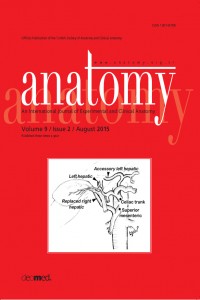Abstract
Misinterpretation of terminology or new creations of anatomical terms can be observed worldwide. Occurring problems because of these invalid terms might be highlighted by an example. During a literature research concerning the saphenous nerve, the sartorial branch of the saphenous nerve was found. As this nerve does not exist in anatomical textbooks as well as in anatomical terminology, we searched for the origin of this branch. In a publication from more than 30 years ago, the reason of the creation of this odd nerve was dyslexia of some authors, reading “sartorial” instead of “saphenous”. This gives reason to think about the pressure at universities to focus only on quantity and not on quality of papers. Literature research is sloppy as well as poor; the knowledge sometimes is even poorer, and in addition time to analyse the content of textbooks and papers are not taken. More dreadful is the fact that the manuscript underwent the regular review process, which indicates that the reviewer did not provide the anatomical knowledge as well. Therefore we are all, as scientist or reviewer, always required to research properly and to review only if we are sure to provide the responsibility of a correct judgement together with the anatomical background.
Keywords
References
- Federative Committee of Anatomical Terminology (FCAT).
- Terminologia Anatomica. Stuttgart: Thieme; 1998.
- Sabat D, Kumar V. Nerve injury during harmstring graft harvest:
- a prospective comparative study of three different incisions. Knee
- Surg Sports Traumatol Arthrosc 2013;21:2089–95.
- Standring S. Nervous System. In: Gray´s anatomy, 38th ed. New
- York: Churchill Livingstone, 1995. p. 1280–2.
- Thiel W. Membrum inferius. In: Hafferl A, editor. Lehrbuch der
- topographischen Anatomie. 2nd ed. Heidelberg: Springer; 1969. p.
- –9.
- Leohnardt H. Plexus lumbalis. In: Rauber/Kopsch Anatomie des
- Menschen. Stuttgart: Thieme; 1988. p. 490–2.
- Meier G, Büttner J. Atlas der peripheren Regionalanästhesie. 3rd
- ed., Stuttgart: Georg Thieme Verlag; 2013. p. 159.
- Hadzic A, Vloka JD. Peripheral nerve blocks: Principles and practice.
- New York: McGraw-Hill; 2004, p. 16–7.
- Niesel HC, Van Aken H. Lokalanästhesie, regionalanästhesie,
- regionale Schmerztherapie. Stuttgart: Georg Thieme Verlag; 2003.
- p. 310.
- Arthornthurasook A, Gaew-IM K. The sartorial nerve: its relationship
- to the medial aspect of the knee. Am J Sports Med 1990;
- :41–2.
- Dunaway DJ, Steensen RN, Wiand W, Dopirak RM. The sartorial
- branch of the saphenous nerve: its anatomy at the joint line of
- the knee. Arthroscopy 2005; 21: 547–51.
- Sanders B, Rolf R, McClelland W, Xerogeanes J. Prevalence of
- saphenous nerve injury afert autogenous harmstring harvest: an
- anatomical and clinical study of sartorial branch injury.
- Arthroscopy 2007;23:956–63.
- Warren F, Marshall JL. The supporting structures and layers on
- the medial side of the knee. J Bone Joint Surg 1979;61:56–62.
- Bertram C, Porsch M, Hackenbroch MH, Terhaag D. Saphenous
- neuralgia after arthroscopically assisted anterior cruciate ligament
- reconstruction with a semitendinous and gracilis tendon graft.
- Arthroscopy 2000;16:763–6.
- Hunter LY, Louis DS, Riccardi JR, O´Connor GA. The saphenous
- nerve: its course and importance in medial arthrotomy. Am J
- Sports Med 1979;7: 227–30.
- Romanes GJ. Cunningham’s Textbook of Anatomy; 11th Ed.
- London: Oxford Medical Education; 1972. p. 760.
Abstract
References
- Federative Committee of Anatomical Terminology (FCAT).
- Terminologia Anatomica. Stuttgart: Thieme; 1998.
- Sabat D, Kumar V. Nerve injury during harmstring graft harvest:
- a prospective comparative study of three different incisions. Knee
- Surg Sports Traumatol Arthrosc 2013;21:2089–95.
- Standring S. Nervous System. In: Gray´s anatomy, 38th ed. New
- York: Churchill Livingstone, 1995. p. 1280–2.
- Thiel W. Membrum inferius. In: Hafferl A, editor. Lehrbuch der
- topographischen Anatomie. 2nd ed. Heidelberg: Springer; 1969. p.
- –9.
- Leohnardt H. Plexus lumbalis. In: Rauber/Kopsch Anatomie des
- Menschen. Stuttgart: Thieme; 1988. p. 490–2.
- Meier G, Büttner J. Atlas der peripheren Regionalanästhesie. 3rd
- ed., Stuttgart: Georg Thieme Verlag; 2013. p. 159.
- Hadzic A, Vloka JD. Peripheral nerve blocks: Principles and practice.
- New York: McGraw-Hill; 2004, p. 16–7.
- Niesel HC, Van Aken H. Lokalanästhesie, regionalanästhesie,
- regionale Schmerztherapie. Stuttgart: Georg Thieme Verlag; 2003.
- p. 310.
- Arthornthurasook A, Gaew-IM K. The sartorial nerve: its relationship
- to the medial aspect of the knee. Am J Sports Med 1990;
- :41–2.
- Dunaway DJ, Steensen RN, Wiand W, Dopirak RM. The sartorial
- branch of the saphenous nerve: its anatomy at the joint line of
- the knee. Arthroscopy 2005; 21: 547–51.
- Sanders B, Rolf R, McClelland W, Xerogeanes J. Prevalence of
- saphenous nerve injury afert autogenous harmstring harvest: an
- anatomical and clinical study of sartorial branch injury.
- Arthroscopy 2007;23:956–63.
- Warren F, Marshall JL. The supporting structures and layers on
- the medial side of the knee. J Bone Joint Surg 1979;61:56–62.
- Bertram C, Porsch M, Hackenbroch MH, Terhaag D. Saphenous
- neuralgia after arthroscopically assisted anterior cruciate ligament
- reconstruction with a semitendinous and gracilis tendon graft.
- Arthroscopy 2000;16:763–6.
- Hunter LY, Louis DS, Riccardi JR, O´Connor GA. The saphenous
- nerve: its course and importance in medial arthrotomy. Am J
- Sports Med 1979;7: 227–30.
- Romanes GJ. Cunningham’s Textbook of Anatomy; 11th Ed.
- London: Oxford Medical Education; 1972. p. 760.
Details
| Primary Language | English |
|---|---|
| Subjects | Health Care Administration |
| Journal Section | Terminology Zone |
| Authors | |
| Publication Date | September 10, 2015 |
| Published in Issue | Year 2015 Volume: 9 Issue: 2 |
Cite
Anatomy is the official journal of Turkish Society of Anatomy and Clinical Anatomy (TSACA).


